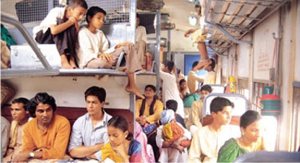President Abdul Kalam's idea of Providing Urban-amenities in Rural Areas (PURA) aims at giving a new thrust to all-round rural development through a mega mission for community empowerment. Perhaps challenging the mega-investment approach, superstar Shah Rukh Khan in Ashutosh Gowariker's Swades charts a simple location-specific path to village development.

![]() Image credit : Ashutosh Gowariker.
Image credit : Ashutosh Gowariker.
Although both aim at pulling out the millions living in abject poverty, squalor and hunger, the two different routes to achieving the same objective bring out the conflict in our understanding of the complex and multi-layered rural crisis.
Ever since he became the President, Kalam has been talking about his vision for a holistic habitat that would improve the quality of life in rural areas. Addressing the first parliamentary session with the UPA government in power, he had spelled out the roadmap. Coming with an apparent technology fix, his dream to transform rural India depends on four critical areas of connectivity: physical connectivity, electronic connectivity, knowledge connectivity, and market connectivity.
Physical connectivity by providing good roads, transport services and quality power; electronic connectivity by providing reliable communication networks; knowledge connectivity by establishing more professional institutions and vocational training centres, schools with high quality infrastructure, primary health centres, recreation centres, and market connectivity that helps realize the best value for the products and services of rural people are all activities that will be reflected in economic growth.
Shah Rukh Khan on the other hand is no social visionary. Neither does he claim to be. He however acknowledged that filming for Swades actually brought him face to face with the harsh ground realities of Bharat. In the film, he portrays the role of a non-resident Indian scientist working with NASA who comes back to his roots to look for his grandmother. Staying in the village, the hero is exposed to the stark realities and numerous contours of social contradictions. He discovers that despite the poverty and deprivation, people have immense wisdom and intellect. He therefore decides to channelise the existing energy and enthusiasm to meet the immediate development needs of the village.
• Brains and bullocks
• Technology for rural women
Realising that technology cannot operate in isolation, Shah Rukh Khan however doesn't make an effort to bring in any component of the sophisticated technology of the rainfall monitoring satellite system that he is involved with at NASA. He goes for a simple appropriate technology that brings electricity to the village, providing them with a ray of hope. The technology is location-specific. He finds that the village has a waterfall. He therefore decides to dam the water and put up a small turbine to generate electricity for the village.
Imagine the thrill on the faces of the village elders to see electricity for the first time after Independence. Let us be very clear. This village needed electricity desperately. So they all got together and did something. Similarly the priority of other villages has to be ascertained before we take a 'one size fits all' approach.
President Kalam's approach is based on a development paradigm that tries to replicate the urban model in the rural areas. For a majority of the educated elite, academicians and the policy makers, who have lost touch with the countryside for generations, PURA is the only way to change the contours and colours of the rural landscape. In fact, such an approach will find immediate support from the engineers, contractors and economists. But, whether the massive infrastructure envisioned in PURA will primarily help the villagers instead of the the engineers, contractors and politicians has yet to be ascertained.

![]() Scene from Swades. Image credit : Ashutosh Gowariker.
Scene from Swades. Image credit : Ashutosh Gowariker.
The questions that naturally crops up is like the big hydel projects and dams, which were contractor and engineer friendly, who would be the real beneficiaries of the PURA initiative? It also remains to be seen whether such high quality infrastructure is what the poor villagers actually need.
Isn't it strange that knowledge connectivity is being pushed at a time when only 43 per cent of the rural households have electricity? Electronic connectivity becomes the government's priority for the rural sector when at least a third of the world's hungry an estimated 320 million are sleeping empty stomach in India. Moreover, at a time when thousands of farmers have committed suicide in the past few years throughout the country, the government's intention of introducing future trading in rice, wheat and other commodities shows the complete bankruptcy in finding alternatives. In India, the average land holding size is 1.47 hectares, and only five to ten percent of the farming population has land holdings exceeding 4 hectares. To expect these farmers, who continue to survive against all odds year after year, to go online and trade can only be the wild imagination someone who has no idea of how the villages look like.
Even physical connectivity with emphasis on a motorised highway is not what the villages would automatically opt for in terms of their immediate priorities. Reports from various parts of the country indicate that the villagers were never consulted on the ambitious pradhan mantri sadak yojna (Prime Minister's road scheme). A majority of the Indian villages would like the government to provide them with basic infrastructure like water harvesting, health centres and employment. Building a four-lane highway with imported technology that does not use local labour is not the idea of development that Swades would promote, and rightly so.
Still, nobody is denying that roads are important. But we need to ask the villagers whether they want a road or something else? Often it has been seen that the villagers (unless they reach a certain level of development, like in Punjab) do not list metalled roads as their immediate priority. In the movie, the village is connected by a road and Khan drives his big van (his working laboratory perhaps) inside the village. He could have asked them to make the road pucca but instead he goes for something that the village needed.
The development model that suits rural India has to be in tune with its special needs, which vary from location to location. Swades has very clearly emphasised on the need for a development process that takes the village requirements, diversity and socio-economic status into consideration. Any development model that is not linked to the priority needs of a village or a community is bound to fail. This has been amply demonstrated throughout the country.
It may require a national debate to determine which of the approaches is ideally suited to transform the rural landscape. But surely there is a lesson in Swades that the President cannot avoid to ignore. Nor can the Indian Diaspora.























